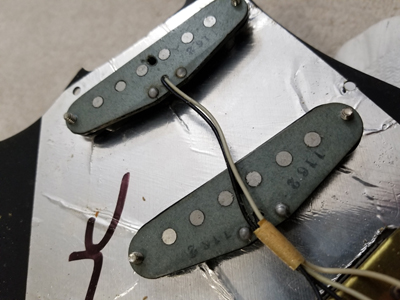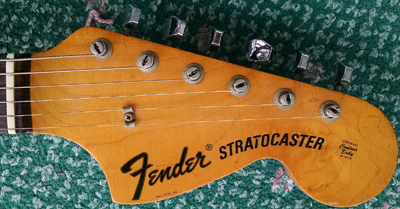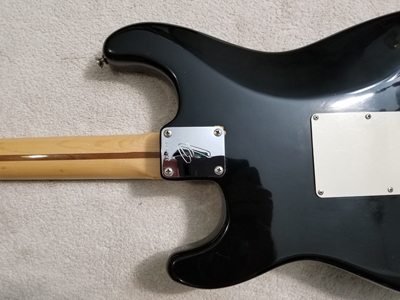Dedicated to identifying Fender Stratocaster guitars during transitional periods (1969 to 1984)
My 1972 Stratocaster The 1971 Neck Date Codes Neck Design Logos Pots Pickups Tuners Switches Saddles Bridges
The Fender Stratocaster guitar is no doubt the most well known guitar ever sold. It has a history of being played by some of the best guitar artist ever known as well. Some of those artist are Jimi Hendrix, Stevie Ray Vaughan, Rory Gallagher, Eric Clapton, Jeff Beck, Robin Trower and Gary Moore. Throughout the years, The Fender Guitar Company has had it's ups and downs. There were times of poor sales, poor production quality and risks of dissolve. These were due to things that included changes in company ownership and changes in personnel at the helm of production. Most notibly was when CBS purchased Fender in 1965. During this time of takeover was the most noticable time of changes in design and sacrifice of production quality. I refer to this time as "the cleanup years". CBS wanted to ramp up production of their guitars and in order to do this they were willing to do and use whatever they could to push out sales of the Fender Stratocaster. This included using parts that traditionally would not have been used. The first transitional times began during this CBS takeover. These changes were mostly correlated at the beginning of a production year. The information found here will help you to identify when those changes were made as well as to help you identify what year a Stratocaster guitar was made and sold.
Identifying your Stratocaster guitar
There are three specific things to take into account when dating a Fender Stratocaster guitar. The date of the neck, the date code stamped on the control pots, and the date code ink stamp on the pickups. These three things can give you the most precise age of the guitar and can help identify what year the guitar was sold. The most recent year between these codes will mean that the guitar was sold in of after that year and will also be considered the production year of the guitar.
Using these three things are fine in determining the production year of a guitar that you know is made up of all original parts. But how do you know if the guitar is all original or not? To do this takes experience. If you don't have the experience, seek out someone who does. Here are just a few things that are examined under close scrutiny in determining whether a guitar is made up of original parts.
1. The wood that makes up the guitar. Fender used select wood for both their necks and bodies. The bodies will have identifying dowel holes. Although they may be impossible to see on a painted guitars, they are easily seen on the non-painted natural wood guitars, or a guitar that has been stripped of it's finish in the dowel location. There is also an extra smaller screw hole in the neck pocket. This was used to hold the body to a wooden jig during painting. The width of the jig is smaller than the width of the pocket. When the jig is in the pocket it is placed toward the top of the pocket. This causes the lower part of the pocket to be exposed during painting. Because of this you may see that the paint, or finish, over-lapped this area inside the neck pocket. The width of that area is usually about 1/2 inch wide. The neck will also at times, but not always, have a smaller screw hole near the other holes (usually in the same area) used to hold the neck to the body. The reason for this screw hole is the same as for the body, although you will not see overlap as you see in the neck pocket.
1. The headstock logo, also called the waterslide. These are known to be replaced. Over the years, Fender used different styles of these logos. They will also have a different patent number, or numbers. Close examination can help identify whether or not it's been replaced.
2. Worker stamps. Although many times there can be different worker stamps on the guitar body and neck, some guitars will have the same worker stamps on both. There were several workers during the year the guitar was assembled at the factory. With experience, you will come to know which stamps were used during those years.
3. Names. Workers will put stamps of their name on the heel end of the neck and at times, in the neck pocket of the guitar body. With experience, you will get to know the names and what years they can be found on the guitar.
4. Solder connections. With experience and maticulas examination, you will be able to tell if the solder connections are original or have been tampered with such as when replacing a part.
5. Pots. Fender used specific pots with specific manufacturer indentifying information on them.
6. Pickups. Fender used pickups that were wound at the Fender factory. They are made out of specific material, have specific production stamps, and their coil windings can be electrically measured to specific tollerances.
7. Plastics and metals. Fender used specific plactic and metal parts for their guitars that were genuien to the times. With ecperience, these are easily identifiable.
Other things that are identifiable are shapes. Fender created their Stratocaster guitars to have specific body contours and headstock shapes. These shapes and contours vairied over the years, sometimes subtile sometimes not so subtile and sometimes not at all. But they always kept a look that was traditional to the esthetics of the Fender Stratocaster guitar.
Before I get started, I'm going to show you one of my own personal Fender Stratocaster guitars which is a perfect example of a transitional period guitar. As a matter of fact, Toby Weaver, an administrator for the Facebook page "1970's Fender Stratocaster Players Club" who witnessed the teardown of this guitar said it best. Quote: " It is the very definition of transitional!". It's a 1972 Fender Stratocaster that I purchased from an estate sale. There has been some modifications to it by the previous owner. Those modifications are, different tuners, a humbucker bridge pickup, black pick guard, black pickup covers, black knobs, black selector switch tip and black tremolo handle. These plastics are normally all white. I guess the original owner wanted to go with an all black theme. Everything else, the neck, the body, the controls and the middle and neck pickups are completely original from the Fender factory. So lets move on to identifying this guitar.
My 1972 Fender Stratocaster Top
A mixture of originally installed Fender parts and after market parts mentioned above.

The neck has a date stamp of 22Nov71B (22=Stratocaster Model,
B=Grade)

The middle pickup tone control is dated 137-7112. (71=year,
12=week).

The neck pickup tone control is dated 137-7202. (72=year, 02=week).

The volume control is dated 137-7202. (72=year, 02=week).

Two original pickups have an ink stamp date of 1162 (1=Winding
Operator, 16=Week, 2=1972).

The bridge saddles are nickel plated rolled steal stamped "FENDER"
and "PAT.PEND" (Pre 1972 design).


The bridge with solid steel block (Pre 1972 design).

The headstock with logo for 1971 with the patent number 2,741,146.
The 1971 Neck Top
During my research into the transitional periods of the '70s Fender Stratocasters, I found that the 1971 model year neck has the most transitional changes than any other year. I have documented some of these changes below.
View: 1971-Gold-Strat-4-Bolt-Early
This first set of pictures is an early '71 maple neck with a '68-'70 logo,
a maple cap neck with no rosewood plug, and a heal stamp date of Jan '71.
This is evident of a transitional period where the decals from previous years
were still being used. This logo with patent numbers 2,741,146 and 3,143,028
was intended to be phased out in 1970.
View: 1971-Sunburst-Strat
The next set of pictures is a mid '71 maple neck with a capped rosewood fret
board, no rosewood plug, no skunk stripe, a logo with a '71 patent number
of 2,741,146 and a heal stamp date of Aug '71.
View: 1971-Natural-Strat-3-Bolt
In this set of pictures is a late '71 maple neck with a bullet truss rod,
a '71 patent number of 2,741,146 and a heal stamp date of Oct 71. This means
that the bullet truss rod started after mid 1971. This also means that it
was during this time that Fender was merging to a new model design consiting
of a three bolt neck which is the reason for the bullet truss rod.
View: My 71 Strat
In this set of pictures, you again see my own Stratocaster neck which has
a heal stamp of Nov '71. This is proof that even though the beginning of the
three bolt neck models had started, Fender continued to use older parts and
produce four bolt models at the same time. This is thought to be to use up
old stock parts and is a perfect example of a transitional period guitar.
: 1972-Bullet-Truss-Neck-71-Patent
In this last set of pictures the neck has a heal stamp of Jan '72. It has
a bullet truss rod yet a patent number of 2,741,146 intended for '70-'71 necks.
This overlap of the patent number is again evident that parts including logos
were used from a previous year as the patent number for 1972 to 1976 Stratocasters
was 3,143,028.
So it appears that in 1971 this was the case.
1. A maple neck with a rosewood or maple cap
never had a skunk stripe or a rosewood plug. With a cap neck, the truss rod
is installed from the front and adjusted at the heal of the neck so no plug
is needed.
2. A maple neck with no skunk stripe and a maple cap has no rosewood plug
and is a four bolt neck. With a cap neck, the truss rod is installed from
the front so no plug needed.
3. A maple neck with a skunk stripe has no capped fret boards. If it has a
rosewood plug it is a four bolt neck with the truss rod installed from the
back of the neck which is adjusted at the heal of the neck. This was implemented
after mid 1971.
4. A maple neck with a skunk stripe has no capped fret boards. If it has a bullet truss rod then it is a three bolt neck and the truss adjustment is made at the headstock.
Date Codes Top
Neck Design Top
Logos Top
Pots Top
Pickups Top
Tuners Top
Switches Top
Saddles Top
Bridges Top








